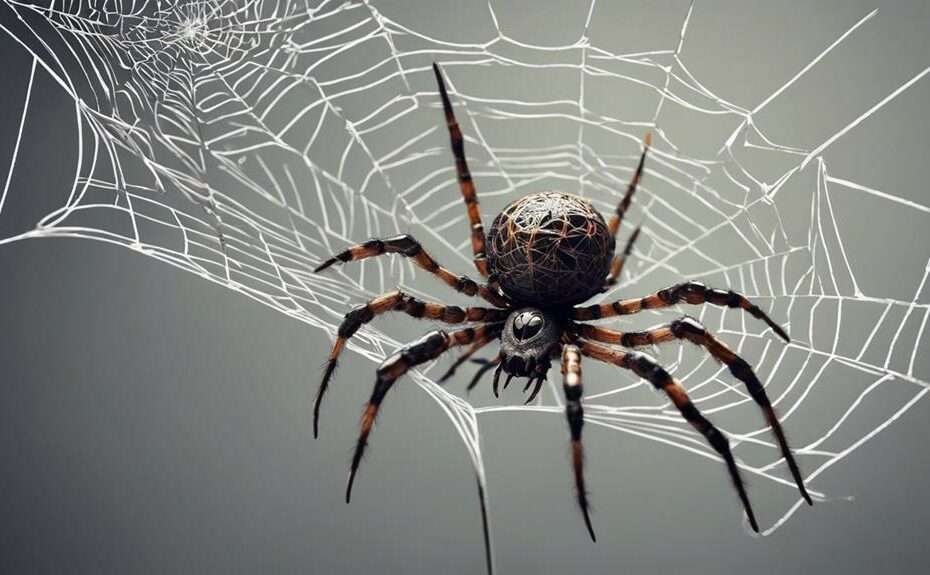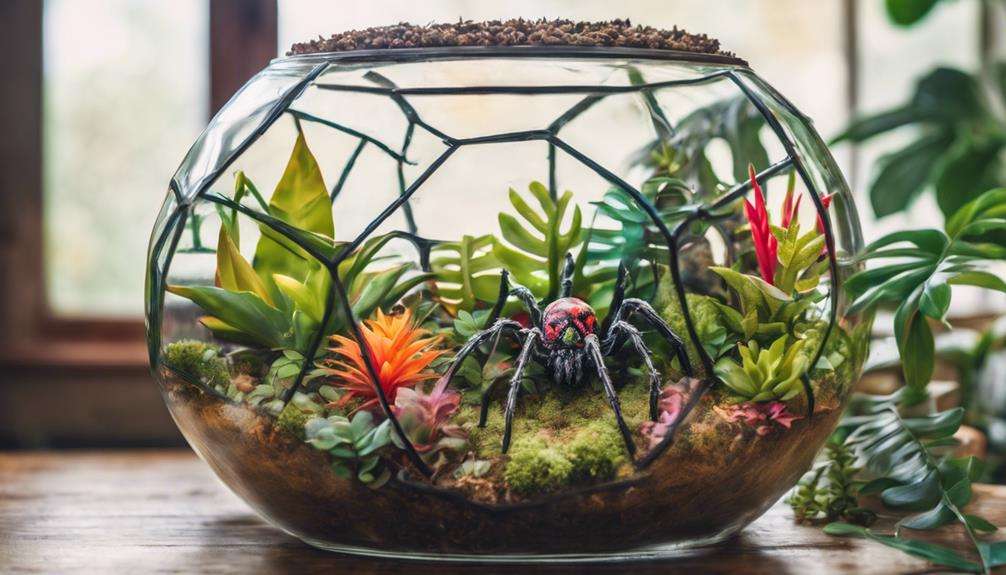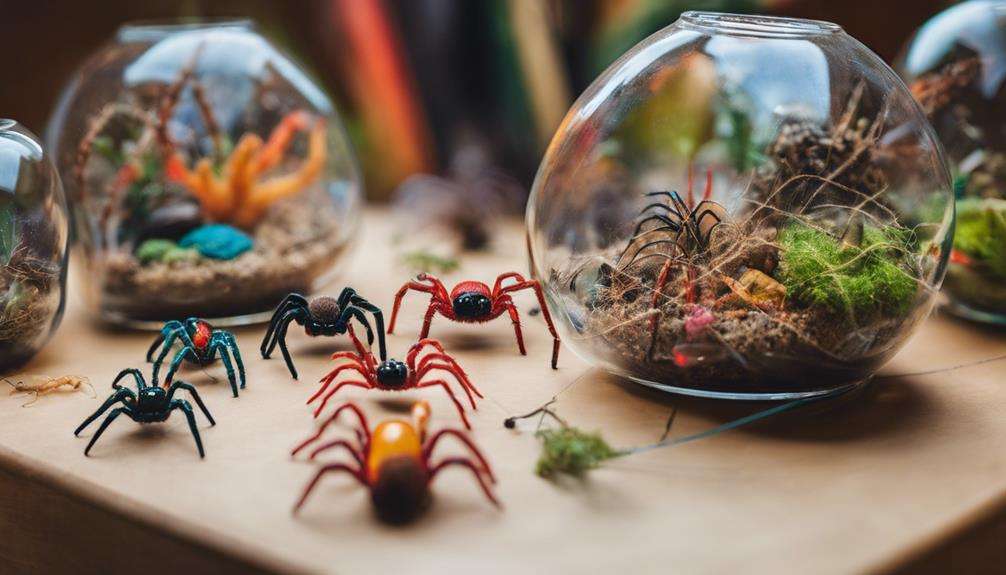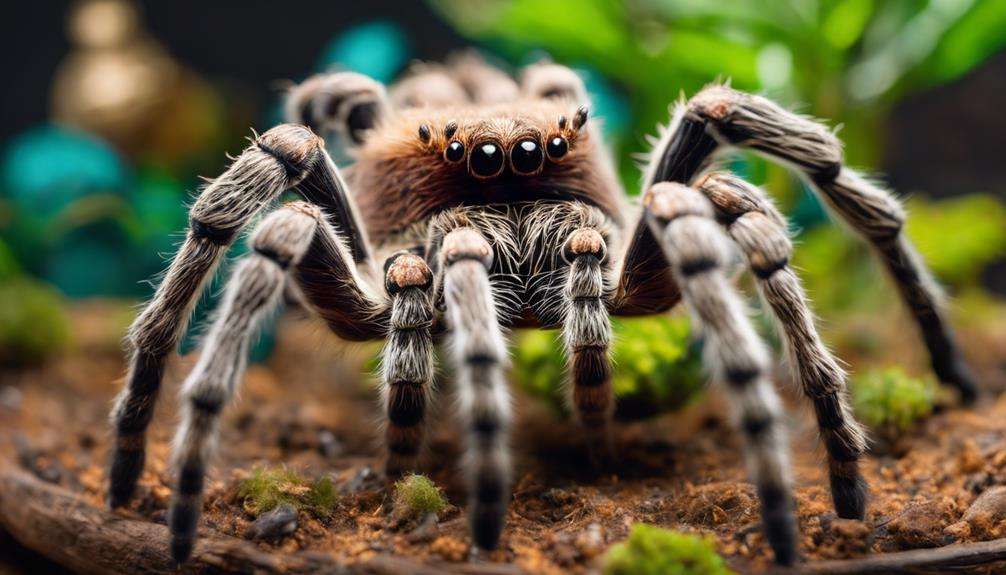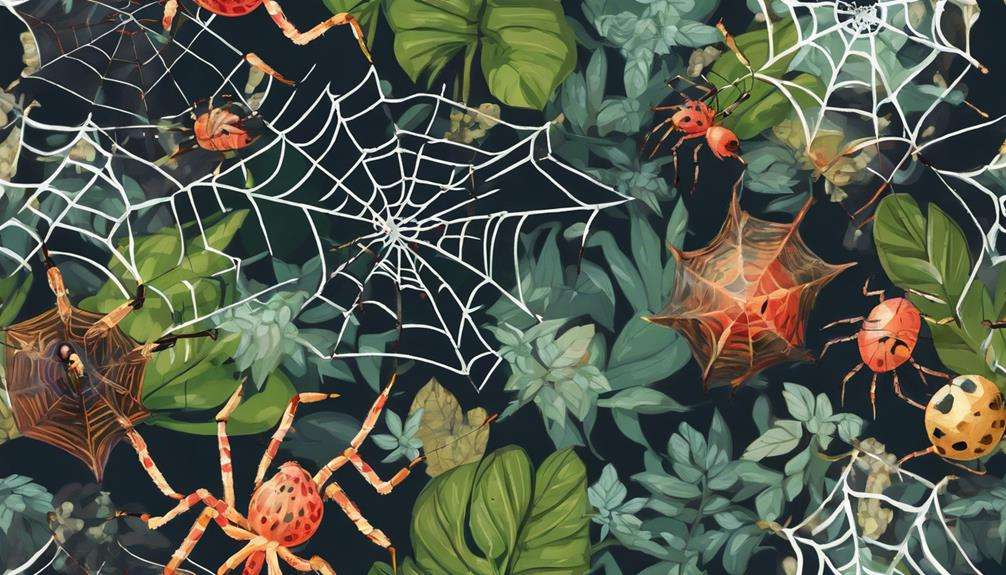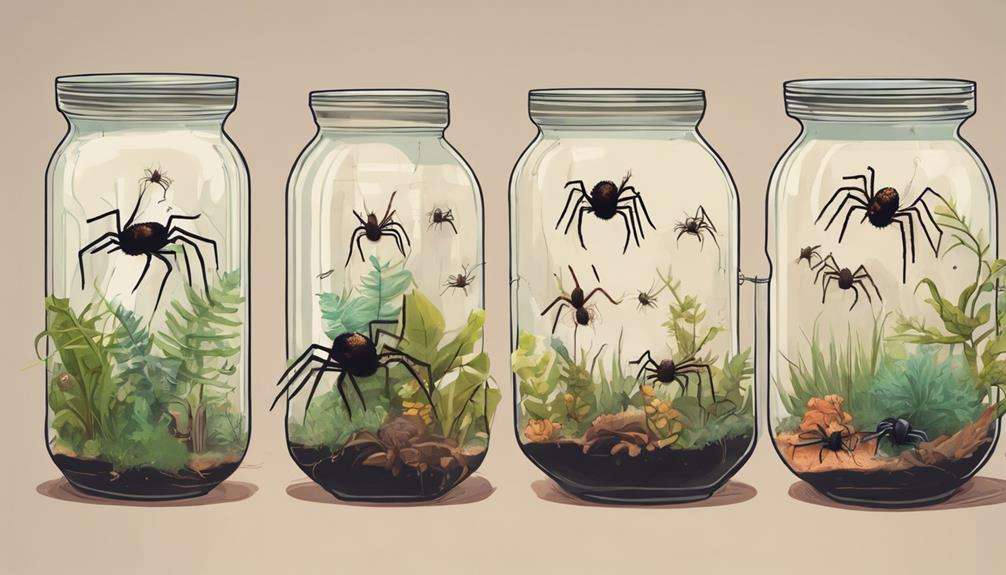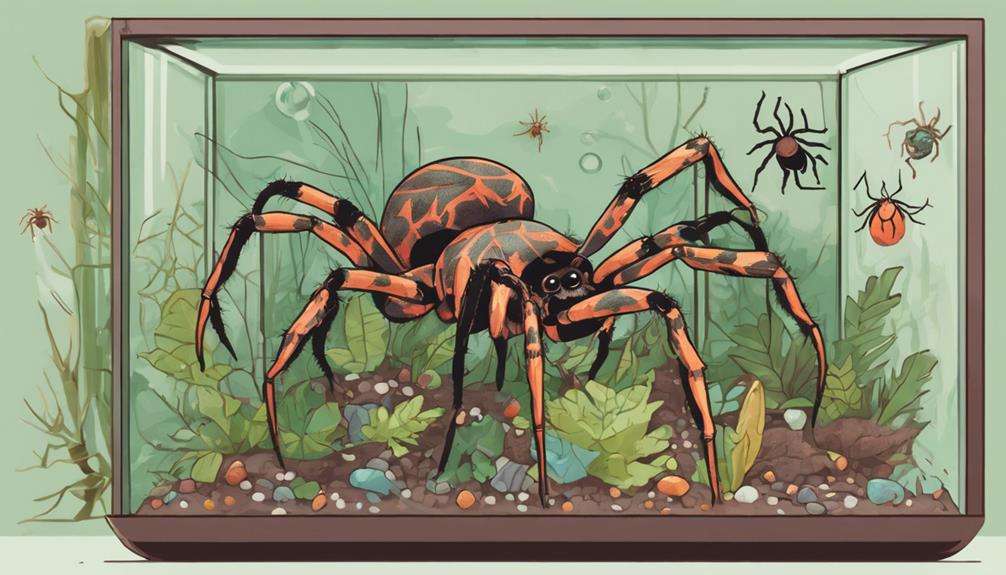Have you ever considered how pet spiders' behavior can be utterly enchanting?
From their intricate hunting techniques to the mesmerizing way they construct their webs, these eight-legged creatures hold a myriad of mysteries waiting to be unraveled.
Exploring the world of pet spiders reveals a domain filled with fascinating interactions, survival strategies, and unique adaptations that will leave you in awe of these enigmatic arachnids.
Key Takeaways
- Pet spiders exhibit intricate communication through vibrations and pheromones.
- Their diverse hunting techniques showcase unique adaptations for survival.
- Silk production and web-building abilities highlight their precision and adaptability.
- Understanding their feeding behaviors and dietary preferences enhances their care and well-being.
Spider Communication and Social Interactions
Spiders communicate and engage in social interactions through a combination of vibrations, pheromones, and touch sensitivity, revealing a complex and fascinating aspect of their behavior. These intricate forms of communication are essential for various social interactions among spiders. Courtship rituals, for instance, involve specific vibrations and pheromones that signal readiness to mate. These rituals can be quite important, with some species showcasing intricate movements and visual displays to attract potential mates.
In addition to courtship, social interactions among spiders may also include maternal care. Female spiders often exhibit remarkable behaviors to protect their eggs and young, demonstrating a level of care and communication within their communities. Silk threads play a vital role in these interactions, conveying information about the spider's presence, reproductive status, or even serving as warnings to other spiders in the vicinity.
Understanding spider communication and social interactions provides valuable insights into their survival strategies and complex behaviors. By delving into these aspects, we gain a deeper appreciation for the fascinating world of pet spiders.
Spider Hunting Techniques and Adaptations
Spider communication and social interactions provide a foundation for understanding the diverse hunting techniques and adaptations that spiders employ to catch and consume prey effectively.
From ambush predation to active hunting and web-building strategies, spiders exhibit a wide array of hunting behaviors. Specialized adaptations such as venomous fangs, silk production, and tactile sensors enhance their hunting efficiency greatly.
Some spiders showcase deceptive hunting skills by mimicking prey or using camouflage to ambush unsuspecting insects. Their hunting strategies vary across species, with some relying on vibrations, visual cues, or chemical signals to locate and capture prey successfully.
Over millions of years, spider hunting adaptations have evolved, resulting in a remarkable range of techniques to secure their survival. By mastering these hunting techniques and utilizing their specialized adaptations, spiders have become efficient predators in their ecosystems, highlighting the intricate and fascinating world of arachnid behavior.
Spider Web Construction and Silk Production
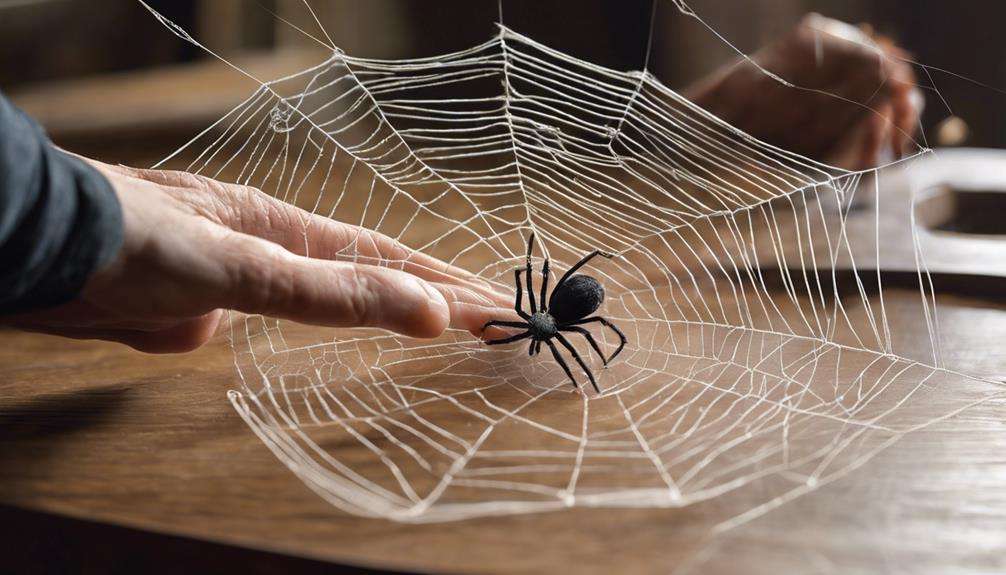
When spiders create their intricate silk threads, they utilize specialized spinnerets on their abdomens.
These silk threads aren't only incredibly strong but also display a variety of uses in web construction.
The patterns and designs in spider webs are tailored for specific purposes, showcasing the complexity of silk production and web-building behaviors.
Silk Spinning Process
Extruding liquid silk through specialized spinnerets located at their abdomen, spiders engage in a remarkable process of silk spinning essential for constructing intricate webs and producing various silk types. Spider silk, a protein-based fiber, boasts adhesive properties and elasticity important for tasks like prey capture, shelter construction, and protecting egg sacs.
This intricate process allows spiders to create webs with exceptional strength and flexibility, making their silk truly remarkable in the natural world. The ability of spiders to produce different types of silk tailored to specific needs showcases the complexity and adaptability of these arachnids. Through the controlled extrusion and solidification of silk, spiders demonstrate a mastery of material science that continues to captivate researchers and enthusiasts alike.
Structural Web Design
In exploring the intricate world of pet spiders, the structural design of their webs reveals a fascinating blend of precision and adaptability in silk production and web construction.
Spiders intricately construct webs using silk produced by specialized abdominal glands through spinnerets located at the rear of their abdomen. These spinnerets enable the creation of various web designs, including sticky and non-sticky threads important for prey capture.
The structural composition of spider webs is tailored to different functions such as trapping prey, providing shelter, forming egg sacs, and communication. Through remarkable adaptations in web design, spiders enhance their hunting efficiency and secure survival by optimizing the use of sticky threads and weaving intricate patterns to secure their prey.
Spider Feeding Behaviors and Diet
Spiders exhibit a diverse range of feeding habits and dietary preferences. Their carnivorous nature drives them to primarily consume insects like flies, crickets, and moths.
Different spider species have developed specialized hunting techniques, from ambush predation to active stalking, to secure their next meal.
Feeding Habits
Among the fascinating behaviors of pet spiders, their feeding habits stand out as an important aspect of their survival and ecological impact. Spiders showcase diverse feeding behaviors, from intricate web-building to actively hunting down prey. Their diet is wide-ranging, including insects, small arthropods, and even small vertebrates. Some spiders rely on venom to immobilize and externally digest their prey before consumption.
Different spider species exhibit varied feeding habits, with some being specialized feeders while others act as generalist predators. These feeding behaviors play an essential role in ecosystems by controlling insect populations and contributing greatly to the food chain. Understanding the intricacies of spider feeding habits provides insights into their essential ecological roles and fascinating behaviors.
Dietary Preferences
Diverse and fascinating, the feeding behaviors of pet spiders provide a glimpse into their survival strategies and ecological impact. Spider diet varies among species, ranging from generalist predators that consume a wide variety of prey to specialist feeders targeting specific insects. Some spiders use venom to immobilize their prey, while others rely on injecting digestive enzymes for external digestion. Understanding the dietary preferences of pet spiders is essential for their health and well-being.
Feeding frequency varies based on species, size, and age, with some requiring regular meals and others capable of extended periods without food. Ensuring appropriate nutrition and feeding schedules for pet spiders is important to support their overall health and vitality.
Spider Molting and Growth Patterns
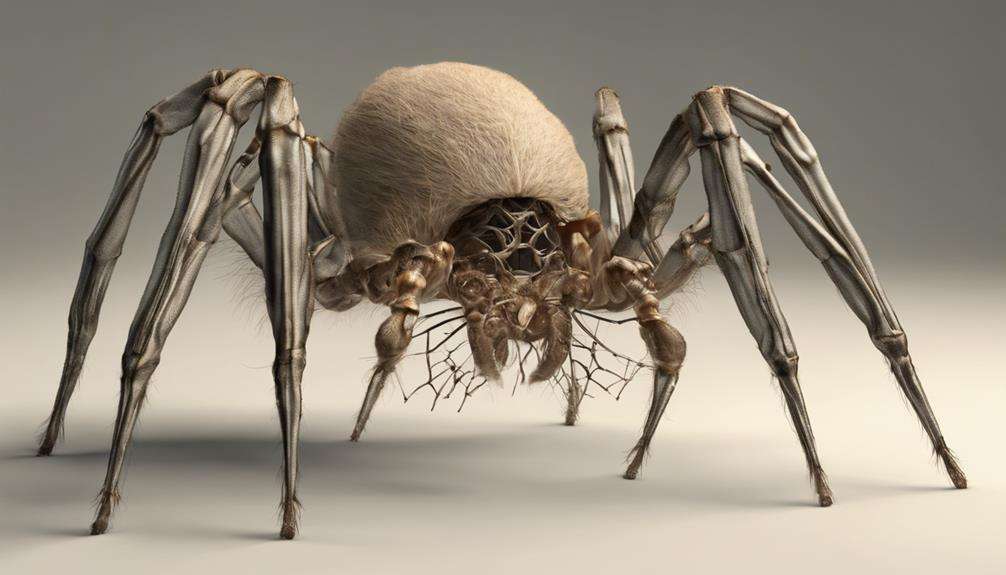
Regularly, spiders undergo molting to facilitate their growth and replace their exoskeleton with a new, flexible one. This process is vital for their development, allowing them to increase in size.
While molting, spiders become vulnerable to predators and environmental stressors, emphasizing the need for a safe and secluded space during this period. The frequency of molting varies among spider species, influenced by factors such as age, size, and environmental conditions.
By observing a spider's molting process, valuable insights can be gained into their growth, health, and overall well-being, especially for those kept as captive pets. Understanding the intricacies of spider molting and growth patterns not only provides a glimpse into their fascinating biology but also helps caretakers guarantee the best possible conditions for their pet spiders' development and happiness.
This process of shedding their exoskeleton and emerging renewed is a fundamental aspect of a spider's life cycle, showcasing the marvels of nature's design.
Spider Territorial Behavior and Defense Mechanisms
Spider territorial behavior and defense mechanisms are essential for their survival strategies. Spiders exhibit territorial behavior to protect vital resources such as food, shelter, and potential mates. Their defense mechanisms, like web vibrations, aggressive postures, and venomous bites, serve to deter intruders and maintain control over their territory.
Territorial disputes among spiders can escalate into physical combat or result in the destruction of webs as they vie for dominance. Dominant spiders use pheromones, silk trails, or fecal deposits to mark their territory and signal ownership, establishing their presence within a given area.
Understanding these behaviors is crucial for creating suitable living environments for pet spiders. By observing and respecting their territorial nature, you can ensure a safe and stress-free environment for your pet spider to thrive in.
Frequently Asked Questions
Why Do People Like Pet Spiders?
You like pet spiders for various reasons. Spider handling teaches responsibility. Spider communication intrigues you. Spider care fosters compassion. Spider feeding shows their needs. Spider habitats mimic nature. Spider bonding creates trust. Spider activities entertain. Spider relationships offer companionship. Spider enrichment enriches. Spider socialization builds connections.
What Traits Are Unique to Spiders?
When it comes to spiders, their unique traits set them apart. From intricate web-building skills to diverse hunting techniques, each aspect of their behavior, like molting processes and territorial instincts, makes them fascinating pets.
Do Pet Spiders Like to Be Held?
When handling pet spiders, consider their preferences and comfort levels. Pay attention to body language, set interaction boundaries, and use gentle handling techniques. Build trust through socialization, respect personal space, follow safety precautions, and create bonding experiences.
Do Pet Spiders Have Personalities?
In pet spiders, you'll notice fascinating quirks. They display unique personalities through behavioral patterns, social interactions, and emotional responses. Observing their individual preferences, communication methods, and learning abilities exposes their playful tendencies, aggressiveness levels, and fear reactions.
Conclusion
As you watch your pet spider carefully navigate its web, you can't help but marvel at the intricate communication, hunting techniques, and web-building skills it possesses.
The way it patiently waits for its prey, the precision in constructing its silk masterpiece, and the graceful movements as it molts and grows – all create a enchanting display of nature's wonders.
With each new observation, you reveal more mysteries and expose the secrets of your fascinating eight-legged friend.
